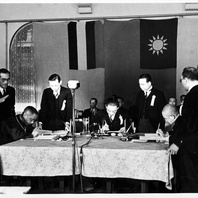
Item
Signing of Japan-Manchukuo-China Joint Declaration
Flanked by courtiers, Zang Shiyi, the Manchukuo ambassador to the RNG (seated to the left), Noboyuki Abe, Japanese ambassador to the RNG (seated to the right), and Wang Jingwei (seated in the centre) sign the Japan-Manchukuo-China Joint Declaration on 30 November 1940, through which RNG China recognised Manchukuo. The Declaration was attached to the Sino-Japanese Basic Treaty, through which Japan formally recognised the RNG. Both documents were signed within the main RNG government compound in Nanjing. The flags of Japan, China and Manchukuo are on the wall behind the men.
Read More
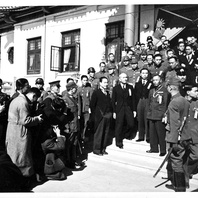
Item
RNG leaders on steps of Government Headquarters, November 1940
Flanked by civilian and military staff, Wang Jingwei, Zang Shiyi (the Manchukuo ambassador to the RNG) and Chu Minyi (RNG foreign minister) pose for photographs in front of the ceremonial hall (litang) in the national government compound in Nanjing after the signing of the Japan-Manchukuo-China Joint Declaration on 30 November 1940, through which RNG China recognised Manchukuo.
Read More
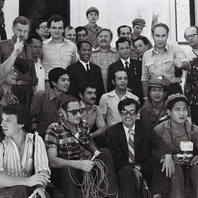
Featured Item
Soldiers and foreign visitors with Heng Samrin and Pen Sovan
This picture shows a group of soldiers and foreign visitors (including journalists) surrounding Heng Samrin (chairman of the People’s Revolutionary Council of the PRK) and Pen Sovan (Secretary-General of the Kampuchea People’s Revolutionary Party). The presence of foreign press and visitors might indicate that the photograph was taken in Phnom Penh at the time of the People’s Revolutionary Tribunal that prosecuted in absentia the ‘Pol Pot-Ieng Sary clique’ for genocidal crimes (15-19 August 1979). This photograph is part of the collection held by the Agence Khmère de Presse (AKP) and Cambodia’s Ministry of Information. This collection, which documents the early years of the People’s Republic of Kampuchea as photographed by the Vietnamese and a small team of Cambodian photographers, has not yet been classified or indexed.
Read More
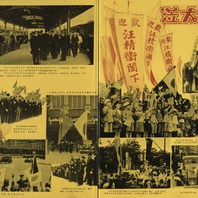
Item
An di Dongjing; li dashiguan (Arriving safely in Tokyo; visiting the embassy)
This photomontage is taken from Huang Qingshu (ed), Wang zhuxi fang Ri jinian huakan (Special pictorial in commemoration of Chairman Wang’s visit to Japan) (Nanjing: Xuanchuanbu, 1941). It includes images of Wang Jingwei arriving in Tokyo during his 1941 visit to Japan, and specifically his visit to the RNG embassy in Tokyo.
Read More
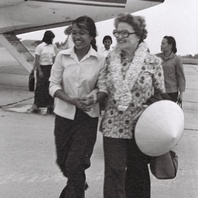
Featured Item
Mean Saman with foreign visitor at Pochentong Airport
This photographs shows of Mean Saman, president of the National Association of Women for the Salvation of Kampuchea, welcoming foreign female visitor (possibly the president of the International Women’s Democratic Federation) at Pochentong airport. The latter has a flower garland around her neck and holds a conical hat (possibly an indication she has been transiting through Vietnam). In the background, one sees the plane’s empennage and a few other Cambodian women. This photograph is part of the collection held by the Agence Khmère de Presse (AKP) and Cambodia’s Ministry of Information. This collection, which documents the early years of the People’s Republic of Kampuchea as photographed by the Vietnamese and a small team of Cambodian photographers, has not yet been classified or indexed.
Read More
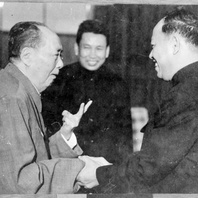
Item
Mao Zedong with Pol Pot and Ieng Sary
This picture shows Mao Zedong with Pol Pot and Ieng Sary during the visit of the Khmer Rouge leaders to Beijing in June 1975. It was featured in the publication (French and English versions) entitled The People’s Republic of Kampuchea (1979). According to the caption which accompanied the image in that publication, the photograph was part of the archives found by the Vietnamese and Kampuchea United Front for National Salvation troops at the Bureau of the Central Committee of the Communist Party of Kampuchea (Office code 870). Mao is shown congratulating Ieng Sary and Pol Pot and, according to the original caption, saying: “Comrades, you have achieved a prodigious victory. In one go, no more classes!” This photograph is part of the collection held by the Agence Khmère de Presse (AKP) and Cambodia’s Ministry of Information. This collection, which documents the early years of the People’s Republic of Kampuchea as photographed by the Vietnamese and a small team of Cambodian photographers, has not yet been classified or indexed.
Read More
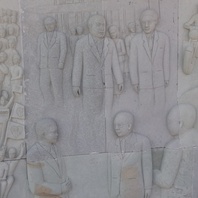
Item
Win-Win Monument bas-relief
This photograph shows a detail of the UNTAC -themed bas-relief on the 117-metre-long engraved base of the Win-Win Monument. It focuses on the Paris Peace Agreements (October 1991),and the (unofficial) meeting between Prince Norodom Sihanouk and Hun Sen. The Win-Win Monument complex – photographed here in January 2020 – was inaugurated in December 2018 to mark the twentieth anniversary of the end of the post-Democratic Kampuchea civil war, with the final defection of the remaining Khmer Rouge factions, thanks to the DIFID policy (“Divide, Isolate, Finish, Integrate, Develop”) also known as the “Win Win” policy of Prime Minister Hun Sen.
Read More
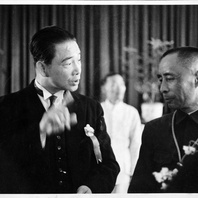
Item
Wang Jingwei with Zang Shiyi
Zang Shiyi (right), the Manchukuo ambassador to the RNG, speaks to Wang Jingwei prior to the both men signing the Japan-Manchukuo-China Joint Declaration on 30 November 1940, through which RNG China recognised Manchukuo. The Declaration was attached to the Sino-Japanese Basic Treaty, through which Japan formally recognised the RNG. Both documents were signed within the main RNG government compound in Nanjing.
Read More
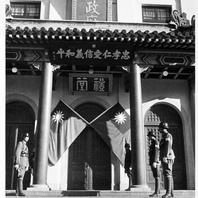
Item
Entrance to RNG Government Headquarters
Chinese and Japanese soldiers guard the entrance to the ceremonial hall (litang) of the national government compound in Nanjing in November 1940. Above the door is a plaque, written by the head of the (non-RNG) national government Lin Sen, which reads: “Loyalty, benevolence, righteousness and peace” (zhongxiao, ren’ai. xinyi, heping). Note that the “unadulterated” Nationalist Chinese flag (without the yellow pennant that the RNG had been forced to attach by the Japanese in spring 1940) is flown here.